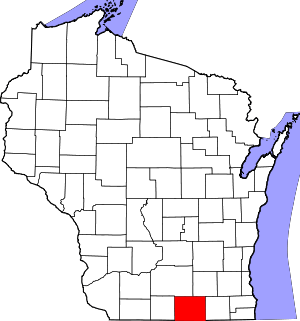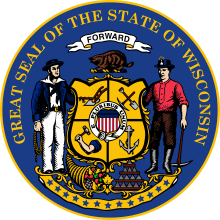Janesville, Wisconsin
Janesville is a city in southern Wisconsin, United States.[5] It is the county seat and largest city of Rock County,[5] is a principal municipality of the Janesville, Wisconsin, Metropolitan Statistical Area and is included in the Madison-Janesville-Beloit, WI Combined Statistical Area. As of the 2010 census, the city had a population of 63,575.[6]
Janesville, Wisconsin | |
|---|---|
| City of Janesville | |
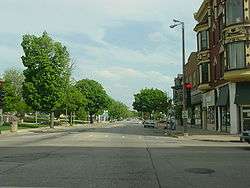 Downtown Janesville looking south on Main Street in 2004 | |
 Flag | |
| Nickname(s): "Wisconsin's Park Place", "Bower City" | |
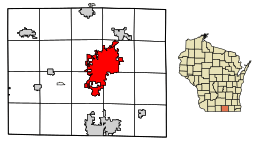 Location of Janesville in Rock County, Wisconsin | |
 Janesville, Wisconsin Location in the contiguous United States | |
| Coordinates: 42°41′2″N 89°0′59″W | |
| Country | |
| State | Wisconsin |
| County | Rock |
| Incorporated | 1853[1] |
| Government | |
| • City manager | Mark Freitag |
| Area | |
| • City | 34.76 sq mi (90.03 km2) |
| • Land | 34.16 sq mi (88.47 km2) |
| • Water | 0.60 sq mi (1.56 km2) |
| Population | |
| • City | 63,575 |
| • Estimate (2019)[4] | 64,575 |
| • Density | 1,890.37/sq mi (729.87/km2) |
| • Metro | 160,092 |
| Time zone | UTC−6 (Central) |
| • Summer (DST) | UTC−5 (CDT) |
| Zip codes | 53545, 53546, 53547, 53548, 53563 |
| Area code(s) | 608 |
| FIPS code | 55-37825 |
| Website | www.ci.janesville.wi.us |
History
The Janesville area was home to many Native American tribes before the settlement of people from the East. With the Indian Removal Act of 1830, many Native American peoples were uprooted and forced out of their homelands to make room for the new settlers, with many Native peoples, including the Ho-Chunk and Potawatomi, being forced onto reservations.[7]
American settlers John Inman, George Follmer, Joshua Holmes, and William Holmes, Jr. built a crude log cabin in the region in 1835.[8] Later that year, one key settler named Henry F. Janes,[1] a native of Virginia who was a self-proclaimed woodsman and early city planner, arrived in what is now Rock County. Janes came to the area in the early 1830s, and initially wanted to name the budding village “Blackhawk," after the famous Sauk leader, Chief Black Hawk, but was turned down by Post Office officials. After some discussion, it was settled that the town would be named after Janes himself and thus, in 1835, Janesville was founded.[9] Despite being named after a Virginian, Janesville was founded by immigrants from New England. These were old stock Yankee immigrants, descended from the English Puritans who settled New England in the 1600s. The completion of the Erie Canal caused a surge in New Englander immigration to what was then the Northwest Territory. Some of them were from upstate New York, and had parents who had moved to that region from New England shortly after the Revolutionary War. New Englanders, and New England transplants from upstate New York, were the vast majority of Janesville's inhabitants during the first several decades of its history.[10][11][12][13] Land surveys encouraged pioneers to settle in the area among the abundance of fertile farmland and woodlands. Many of these early settlers established farms and began cultivating wheat and other grains.
Some of the key settlers hailed from the burned-over district of western New York State, (an area notable for being a part of the Christian revival movement known as the Second Great Awakening). Some of those in that revival movement were also active in the abolitionist and women's rights movements.[9] One of the settlers in Janesville was William Tallman, who hailed from Rome, New York. Tallman came to the area in 1850 and bought up large tracts of land in hopes of inspiring his fellow New Yorkers to settle in the fertile Rock County. He established himself as one of the most influential and affluent members of the budding Janesville populace. He was passionate about the call for abolition and became a supporter of the Republican Party. One of the crowning moments in Tallman's life was when he convinced the up-and-coming Illinois Republican, Abraham Lincoln, to speak in Janesville in 1859. The Tallman house is now a historical landmark, and best known as “The place where Abraham Lincoln slept.”[9]
As the population grew in the Janesville area, several new industries began cropping up along the Rock River, including flour and lumber mills. The first dam was built in 1844.[9]
Janesville was very active during the Civil War. Local farms sold grains to the Union army, and Rock County was one of the counties in Wisconsin with the highest number of men enlisted.[9] Thomas H. Ruger, of Janesville, served in the war, along with his brothers, Edward, William, and Henry, and he rose to the rank of brigadier general. Ruger later served as military governor of Georgia, and commandant of West Point. He is memorialized at Fort Ruger in Diamond Head, Hawaii.[14]
After the Civil War, Janesville's agriculture continued to surge and a greater demand for new farming technology led to the development of several foundries and farm machine manufacturers in the area, including the Janesville Machine Company, and the Rock River Iron Works. With the boom in the farm service sector and establishment of a rail system, Janesville soon began to ship goods to and from prominent eastern cities, including New York, Boston, and Philadelphia. After decades of rigorous grain farming, the soil quality around Janesville began to degrade. Farmers responded to this by planting tobacco, which became one of the most profitable and prolific crops grown in Wisconsin during the late 19th century.[9]
Another development during the mid-19th century was the establishment of a women's rights movement in Janesville. The movement was founded in the 1850s and continued after the Civil War. One of the key focuses of the group during the 1870s was the Temperance movement.
In the late 1880s, German immigrants began to arrive in Janesville in large numbers (making up less than 5% of the town before this time). They were the largest non-English-speaking group to settle there. Unlike in some other areas, in Janesville, they experienced virtually no hostility or xenophobia. Janesville's founding English-Puritan-descended Yankee population welcomed them with open arms, with many writing back to relatives in Germany enthusiastically. This led to chain migration which increased the German population of the town.[15] Only one German-language newspaper was founded in the town; it was known as The Janesville Journal, and began in 1889, printing for only a few years.[16]
In the late 19th and early 20th centuries, the Milwaukee Road and Chicago and North Western railroads had freight and passenger rail connections to the city. Passenger rail service continued until 1971.[17]
One of the key developments in Janesville's history was the establishment of a General Motors plant in 1919. The plant was initially established to produce Samson tractors, a company acquired by GM co-founder William C. Durant. Durant was encouraged by Joseph Craig, the president of Janesville Machine, to build a plant to produce the Samson tractors in Janesville, to which Durant agreed. In the years following World War I, the demand for tractors plummeted and the plant shifted its focus to the production of automobiles.[9]
One of the most prominent turns of the century figures in Janesville was George Parker, who developed new pen technologies and styles and eventually established the Parker Pen Company. His developments included the “lucky curve” ink feed system and the “trench pen”—a pen commissioned by the U.S. Army for use in World War I. Parker designed and established a headquarters and factory in downtown Janesville. The Parker Pen Company was handed down to George's son, Ken, who developed the revolutionary “Parker 51” in the 1940s. A Parker pen was used by Dwight D. Eisenhower to sign Germany's Armistice agreement to end World War II in Europe, and subsequently General Douglas MacArthur used his 20-year-old Parker Duofold in the signing of Japan's surrender at the end of the War in the Pacific. The Parker Pen Company was one of the top employers in the area for over 70 years. The company was eventually sold off in a leveraged buyout in the 1980s.[9]
Another important figure in Janesville's history was John Nolen, who was hired by the city in 1919. Nolen was a city planner who saw the Rock River as a focal point for community and park development. His park planning established Janesville as the “City of Parks.”[9]
Janesville was the site of the first Wisconsin State Fair in 1851, attended by approximately 10,000 people.[18]
Lavinia Goodell, Wisconsin's first female lawyer (1874), lived in Janesville.[19]
A tree that once stood in downtown Courthouse Park was the site of a lynch mob that, on their second attempt, having been rebuffed by an opposing crowd the day before, hanged a convicted murderer in 1859.[20] The location of a KKK rally in 1992 is now "Peace Park" with a playground and a peace pole, which when constructed was the tallest in the world and is now the second tallest.[21]
National Register of Historic Places
The 1857 Lincoln-Tallman House, which models the Italian Villa-style architecture, is one of 34 sites on the Register.[22] Abraham Lincoln slept there for two nights.[23] The Columbus Circle neighborhood became Janesville's tenth historic district in 2005.
The old Janesville Public Library, located at 64 S. Main Street, was designed by J.T.W. Jennings, and opened to the public in 1903. It is described, in the NRHP Nominating Form, as "among the best Neoclassical Carnegie libraries in the state."[24] The Courthouse Hill Historic District was added in 1986.[25] In 1976, the Lappin-Hayes Block, once the site of the cabin belonging to Henry Janes, was added.[26] The Lovejoy and Merrill-Nowlan Houses, the residences of two Janesville Mayors, including Allen P. Lovejoy, were added in 1980.[27] During the following year, the Janesville Public Library building became part of the list. The Frances Willard Schoolhouse, partially built by Josiah Willard and named after his daughter, Frances, was added in 1977.[28] The South Main Street Historic District joined the list in 1990 and the Jefferson Avenue Historic District was included in 2006. In 2008, the John H. Jones House was listed.
City flag
Janesville developed its first flag in 2015 in a design contest held in Janesville's schools. The winning flag was adopted by the city council in March 2015 and unveiled on June 15, 2015. The flag represents the community's past, present, and future, with 1853 representing the year Janesville was incorporated, four stars symbolizing the city's four original wards, a green background standing for the community's agricultural industry, and black representing both the rich soil for which Janesville is known, and the smoke that billowed from smokestacks as the community developed a manufacturing economy. The tree in the center is the city's logo, representing Janesville's slogan, "Wisconsin’s Park Place."[29]
Geography
According to the United States Census Bureau, the city has a total area of 34.45 square miles (89.23 km2), of which 33.86 square miles (87.70 km2) is land and 0.59 square miles (1.53 km2) is water.[30] The city is divided by the Rock River.
Climate
Like the rest of Wisconsin the climate is humid continental, but its location is in the transition from warm to warm summers in the eastern and northern part of the state. Nowadays the city is the first choice, ie Dfa for Köppen classification where the hot season may not be so comfortable at times, although surges in the outskirts without UHI are in the Dfb zone. The city is at 5a / 5b in the USDA Plant Hardiness Zone.[31]
| Climate data for Janesville, elevation: 240 m or 790 ft, 1980-2012 normals and extremes | |||||||||||||
|---|---|---|---|---|---|---|---|---|---|---|---|---|---|
| Month | Jan | Feb | Mar | Apr | May | Jun | Jul | Aug | Sep | Oct | Nov | Dec | Year |
| Record high °C (°F) | 16.0 (60.8) |
19.0 (66.2) |
25.6 (78.1) |
33.0 (91.4) |
34.4 (93.9) |
36.0 (96.8) |
38.0 (100.4) |
35.0 (95.0) |
36.1 (97.0) |
32.0 (89.6) |
25.0 (77.0) |
21.0 (69.8) |
38.0 (100.4) |
| Average high °C (°F) | −3.1 (26.4) |
−0.3 (31.5) |
7.0 (44.6) |
14.8 (58.6) |
20.6 (69.1) |
25.5 (77.9) |
28.1 (82.6) |
26.7 (80.1) |
22.8 (73.0) |
16.2 (61.2) |
8.7 (47.7) |
−0.4 (31.3) |
13.9 (57.0) |
| Daily mean °C (°F) | −6.4 (20.5) |
−3.9 (25.0) |
2.4 (36.3) |
9.5 (49.1) |
15.3 (59.5) |
20.5 (68.9) |
23.2 (73.8) |
21.8 (71.2) |
17.3 (63.1) |
10.9 (51.6) |
4.5 (40.1) |
−3.3 (26.1) |
9.3 (48.8) |
| Average low °C (°F) | −9.9 (14.2) |
−7.6 (18.3) |
−1.9 (28.6) |
4.3 (39.7) |
9.9 (49.8) |
15.2 (59.4) |
17.7 (63.9) |
16.7 (62.1) |
12.0 (53.6) |
5.9 (42.6) |
0.5 (32.9) |
−6.8 (19.8) |
4.7 (40.4) |
| Record low °C (°F) | −31.0 (−23.8) |
−29.3 (−20.7) |
−22.0 (−7.6) |
−9.9 (14.2) |
−3.0 (26.6) |
3.0 (37.4) |
8.0 (46.4) |
5.0 (41.0) |
−2.1 (28.2) |
−6.6 (20.1) |
−22.1 (−7.8) |
−29.0 (−20.2) |
−31.0 (−23.8) |
| Average precipitation mm (inches) | 36 (1.4) |
33 (1.3) |
56 (2.2) |
79 (3.1) |
89 (3.5) |
109 (4.3) |
96 (3.8) |
102 (4.0) |
99 (3.9) |
66 (2.6) |
56 (2.2) |
41 (1.6) |
862 (33.9) |
| Average snowfall cm (inches) | 27.9 (11.0) |
22.9 (9.0) |
10.2 (4.0) |
2.5 (1.0) |
0.0 (0.0) |
0.0 (0.0) |
0.0 (0.0) |
0.0 (0.0) |
0.0 (0.0) |
0.0 (0.0) |
5.1 (2.0) |
22.9 (9.0) |
91.5 (36) |
| Average snowy days | 6.1 | 4.6 | 2.7 | 0.4 | 0.0 | 0.0 | 0.0 | 0.0 | 0.0 | 0.1 | 1.1 | 5.8 | 20.8 |
| Source 1: Climatebase.ru[32] | |||||||||||||
| Source 2: US Climate Data (snowfall, 1981-2010)[33] and Weatherbase[34] | |||||||||||||
| Climate data for Janesville (Power substation), elevation: 76 m or 249 ft, extremes and average extremes 1893-1895, 1915-1917, 1945-1987 | |||||||||||||
|---|---|---|---|---|---|---|---|---|---|---|---|---|---|
| Month | Jan | Feb | Mar | Apr | May | Jun | Jul | Aug | Sep | Oct | Nov | Dec | Year |
| Record high °C (°F) | 16 (60) |
18 (65) |
28 (83) |
33 (91) |
35 (95) |
38 (100) |
39 (102) |
38 (100) |
38 (101) |
32 (89) |
26 (78) |
18 (65) |
39 (102) |
| Mean maximum °C (°F) | 7.4 (45.4) |
9.4 (48.9) |
19.7 (67.4) |
27.1 (80.7) |
30.7 (87.3) |
33.8 (92.9) |
34.9 (94.9) |
34.3 (93.8) |
32.2 (90.0) |
27.2 (80.9) |
19.3 (66.7) |
11.4 (52.5) |
35.9 (96.7) |
| Mean minimum °C (°F) | −25.2 (−13.3) |
−22.3 (−8.2) |
−14.8 (5.4) |
−5.4 (22.2) |
0.2 (32.4) |
6.2 (43.2) |
9.6 (49.2) |
8.1 (46.6) |
1.8 (35.3) |
−3.4 (25.9) |
−12.7 (9.2) |
−21.1 (−6.0) |
−26.3 (−15.3) |
| Record low °C (°F) | −33 (−28) |
−31 (−24) |
−25 (−13) |
−15 (5) |
−8 (17) |
0 (32) |
5 (41) |
4 (40) |
−3 (27) |
−12 (11) |
−27 (−17) |
−32 (−25) |
−33 (−28) |
| Source: WRCC[35] | |||||||||||||
Demographics
| Historical population | |||
|---|---|---|---|
| Census | Pop. | %± | |
| 1860 | 7,703 | — | |
| 1870 | 8,789 | 14.1% | |
| 1880 | 9,018 | 2.6% | |
| 1890 | 10,836 | 20.2% | |
| 1900 | 13,185 | 21.7% | |
| 1910 | 13,894 | 5.4% | |
| 1920 | 18,293 | 31.7% | |
| 1930 | 21,628 | 18.2% | |
| 1940 | 22,992 | 6.3% | |
| 1950 | 24,899 | 8.3% | |
| 1960 | 35,164 | 41.2% | |
| 1970 | 46,426 | 32.0% | |
| 1980 | 51,071 | 10.0% | |
| 1990 | 52,133 | 2.1% | |
| 2000 | 59,498 | 14.1% | |
| 2010 | 63,575 | 6.9% | |
| Est. 2019 | 64,575 | [4] | 1.6% |
| U.S. Decennial Census[36] | |||
2010 census
As of the census[37] of 2010, there were 63,575 residents, 25,828 occupied housing units, and 16,718 families in the city. The population density was 1,877.6 people per square mile (834.1/km2). The racial makeup of the city was 91.7% White, 2.6% Black or African American, 0.3% Native American, 1.3% Asian, 0.0% Pacific Islander, 2.0% from other races, and 2.1% from two or more races. 5.4% of the population were Hispanic or Latino of any race.
Of the 25,828 households, 30.4% had children under the age of 18 living in them, 46.6% were married couples living together, 12.7% had a female householder with no husband present, and 35.3% were non-families. 28.2% of all households were made up of individuals, with 10.6% individuals aged 65 years or older. The average household size was 2.43 and the average family size was 2.95.
In the city, the population was spread out, with 21.8% under the age of 18, and 13.9% who were 65 years of age or older. The median age was 37.1 years.
As of 2015, the median household income was $49,001.[38] Per capita income in past 12 months (in 2015 dollars), 2011-2015 was $25,461.[39] Percentage of people living in poverty 2011-2015 was 15.2%.[39]
Government
Janesville has had a city manager-council form of government since 1923.[40] The city council consists of seven members, elected at large for two-year terms.
Janesville is represented by Stephen Nass (R) and Janis Ringhand (D) in the Wisconsin State Senate, and Amy Loudenbeck (R) and Debra Kolste (D) in the Wisconsin State Assembly. Bryan Steil (R) represents the city in the United States House of Representatives, and Ron Johnson (R) and Tammy Baldwin (D) in the United States Senate.
Economy
Businesses headquartered in Janesville include Impact Confections, a candy maker; Blain's Farm and Fleet, a three-state retail chain; Woodman's Food Market, a regional supermarket chain that built its first store in Janesville; Swing'n'Slide, a maker of wood-and-plastic playground equipment; Hufcor (formerly Hough Shade Company), a manufacturer of room dividers that markets internationally; and Gray's Brewing, maker of boutique beers and soft drinks.
From 1919 until 2008, Janesville was the site of the Janesville GM Assembly Plant. Begun in 1919, when GM bought the Janesville Machine Company and merged it with the Samson Tractor Company, the Janesville plant was the oldest General Motors plant in North America prior to its closing. It assembled light-duty trucks and sport utility vehicles,[41] which declined in popularity as gasoline prices increased.[42] The plant closed in December, 2008.[43][44] Production of General Motors sport-utility vehicles ended on December 23 and the remaining medium-duty Isuzu assembly line ended operations on April 23, 2009.[45]
The Parker Pen Company was founded in Janesville. At one time its factory was the largest writing instrument plant in the world. The company later purchased Manpower, Inc., but eventually sold the pen business to Gillette, which closed the factory in 2000.[46] The Northwestern Mutual Life Insurance Company was founded in Janesville in 1857 but moved to Milwaukee two years later.
The Janesville Mall redeveloped in the late 1990s, and in 1998 Pine Tree Plaza opened. In November 2006, a Walmart Supercenter and a Sam's Club opened after a period of controversy.
The site of the former Janesville Oasis, known for Bessie, a large fiberglass cow at its entrance, began redevelopment in 2007; the anchor tenant is a Super Menards. Bessie the cow was spared by popular demand.[47][48]
Largest employers
As of 2015, the largest employers in the city were:[49]
- Mercy Health System
- Janesville School District
- Rock County
- Blackhawk Technical College
- Data Dimensions Corporation
- Seneca Foods
- City of Janesville
- Prent Corporation
- Blain Supply/Blain's Farm & Fleet
- SSI Technologies, Inc.
- J. P. Cullen and Sons
- Dean Clinic - Janesville East
- Lemans Corporation
- St. Mary's Janesville Hospital
- Bliss Communications
- Chambers & Owen
- Simmons
- HUFCOR
- Amtec Corporation
- W.W. Grainger, Inc
Transportation
Buses
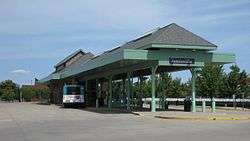
Janesville operates a bus system, the Janesville Transit System (JTS), which also connects with neighboring Beloit. Van Galder Bus Company (a Coach USA company), based in Janesville, operates a regional bus service between Madison and downtown Chicago, Chicago O'Hare Airport, and Midway Airport.
Major highways
Interstate 90/39 passes through Janesville, as does U.S. Hwy 14 and 51 and state Hwy 26 and 11.
Airport
Janesville is served by Southern Wisconsin Regional Airport (KJVL), which provides general aviation and air cargo services. The closest airports with commercial air service are Dane County Regional Airport in Madison and Chicago Rockford International Airport in Rockford, Illinois.
Rail
The city is served by three freight railroads: Union Pacific, which has two daily freight trains between Janesville and Chicago; the Wisconsin and Southern Railroad, a regional carrier that provides freight service to cities throughout southern Wisconsin; and the Iowa, Chicago and Eastern Railroad, a subsidiary of the Canadian Pacific Railway, that operates a weekly train to Chicago.[50]
Media
The Janesville Gazette,[51] owned by Adams Publishing Group, is one of two daily newspapers in Rock County, Wisconsin, (the Beloit Daily News[52] is the other), and serves a regional market stretching into Walworth County. Delavan-based Community Shoppers, Inc. publishes the bi-weekly Janesville Messenger.[53]
Janesville has two television stations licensed to the city: Ion Life-affiliated WIFS (Channel 57), which has its offices and transmitter in Madison and serves all of south-central Wisconsin, and WDNW-LD (Channel 45), a low-power translator station of the Trinity Broadcasting Network. Janesville is in the Madison television market and is served by Madison stations WISC (CBS), WMTV (NBC), WKOW (ABC) and WMSN (Fox), and was originally apart of the Rockford television market. Janesville is served by at least five radio stations: WJVL (99.9 FM, Janesville), WSJY (107.3 FM, Fort Atkinson), WWHG (105.9 FM, Evansville), WSLD (104.5 FM, Whitewater), and WCLO (1230 AM, Janesville).
Education
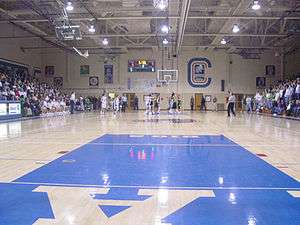
The School District of Janesville[54] has twelve elementary schools, three middle schools, two high schools, and five charter schools. In addition, there are seven parochial elementary and middle schools and one parochial high school.
The Wisconsin School for the Blind and Visually Impaired[55] has been located in Janesville since 1849 and state-run since 1850.[1] A two-year community college, the University of Wisconsin–Rock County, located on the southwest side of Janesville, is part of the University of Wisconsin System. A two-year technical college, Blackhawk Technical College, is located midway between Janesville and Beloit; Blackhawk also offers degree programs through Upper Iowa University.
Hedberg Public Library
The library began in 1865 as a privately supported reading room for the Young Men's Library Association. After a referendum passed in 1884, it became a public library that was housed in rented quarters. In 1903, a new building was constructed with $30,000 from Andrew Carnegie and other donors. The city also agreed to appropriate $3,000 for library operations. The library then moved to its first official home across from the Rock County Court House on Main Street. When it outgrew these quarters in the early 1960s, a new library was built in 1968 at 316 S. Main Street.
Just 20 years later, the library began planning for expanded space. With $4.6 million donated by Don and Gerry Hedberg, local philanthropists, as well as city and other donated monies, an expanded and completely renovated library was opened in 1996. Janesville's public library was then renamed Hedberg Public Library in honor of its largest contributors.[56] The library is part of the Arrowhead Library System.
Parks and recreation
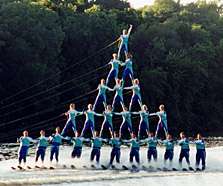
Janesville is known as "Wisconsin's Park Place". Its 2,590-acre (10.5 km2) park system includes 64 improved parks, as well as boat launches, golf courses, and nature trails.[57] This is one of the highest acreages per capita in Wisconsin.
Janesville has a public, internationally themed botanical garden, Rotary Gardens, that was created from an abandoned sand pit.
Traxler Park is home to the Rock Aqua Jays, a water ski team. The RAJ's are the most successful water ski show team in the world with 62 total tournament victories including 19 U.S. National Championships. The team originated and regularly hosts the National Show Ski Championships, and was the host of the first ever World Water Ski Show championship, with teams competing from Australia, Belgium, Canada, and China. Traxler Park is also the site of the city's annual Fourth of July festivities.
Other major parks include Riverside Park, a recreational park along the Rock River including a golf course and a segment of the Ice Age Trail; Rockport Park, largely undeveloped, including the municipal swimming pool and Peace Park; Monterey Park, including the Big Rock, an early natural landmark signaling a good ford of the Rock River (and the namesake of the county, but not the river), as well as a sports stadium used by the school system; Lustig Park, used for a disc golf course; and Palmer Park, which includes a 9-hole golf course and CAMDEN Playground (an accessible play area, considered the largest accessible/integrated playground in the world and the most accessible/integrated playground). Most of the hiking and biking trails in the city are connected to the Ice Age Trail, which will eventually connect to the west with the Sugar River State Trail, north to Milton and Fort Atkinson and east to the Kettle Moraine State Forest.[58]
Janesville also has a nearly 500-acre greenbelt system to provide areas for surface water runoff and habitat for a diversity of plants and animals.
Religion
There are four Roman Catholic parishes in Janesville, all part of the Diocese of Madison. The oldest is St. Patrick's, established in a log chapel in 1844 when there were only six Catholic families in Janesville. A Priest arrived in March 1845 and celebrated mass. St. Patrick's present church was built of cream colored brick in 1863 and is located at 315 Cherry Street. Located on a hill near the center of town, the architecturally prominent Nativity of Mary church (St. Mary's) was organized in 1876 by German immigrants who wanted a parish of their own. The present red brick structure was completed in 1902. The remaining two Janesville parishes include St. John Vianney, located on East Racine Street, and St. William on the near west side.
The city is also home to many other Christian churches including Lutheran, Methodist, Episcopalian, Baptist, and others. The First Baptist Church of Janesville was organized October 13, 1844, and founded by the Rev. Jeremiah Murphy. The Seventh Day Baptist General Conference has its offices in Janesville; the denomination's nearest church is in nearby Milton. All Saints Anglican Catholic Church[59] a part of the continuing Anglican movement, is located in a historic church near downtown that was built by German Lutherans in the 1880s.
There are four cemeteries in Janesville: Oakhill, a municipal cemetery, Mount Olivet, a Roman Catholic cemetery, Dillenbeck Cemetery,[60] and Milton Lawns, a non-demominational private cemetery.
The Gideon Bible organization was founded at the Janesville YMCA in 1899 by Janesville resident John H. Nicholson and a Beloit man after they had shared a Boscobel hotel room.[61]
Janesville has a mosque.[62]
Sports
In fall 2009, Janesville became home to the Janesville Jets, an expansion team in the North American Hockey League, with games played at the Janesville Ice Arena. The Janesville Cubs, a minor league baseball team affiliated with the Chicago Cubs, was based in Janesville from 1941 to 1942 and 1946 to 1953. They were called the Bears in 1946.
Notable people
- David Adamany, president of Temple University 2000-2006
- C. S. Amsden, President pro tempore of the South Dakota Senate and Speaker pro tempore of the South Dakota House of Representatives
- William A. Barstow, Governor of Wisconsin, Union Army general
- Mistie Bass (Mistie Williams), WNBA player
- Leslie Allen Bellrichard, Medal of Honor recipient, Vietnam[63]
- James Bintliff, Union Army general
- Victor Bleasdale, Navy Cross and Distinguished Service Cross recipient[64]
- Frank Bliss, MLB player
- Harry W. Bolens, Wisconsin State Senator
- William B. Britton, Wisconsin State Representative
- James H. Budd, California governor, 1895–1899
- Stephen Bolles, U.S. Representative, 1939–1941
- Frank Matteson Bostwick, U.S. Navy Commodore
- Zebulon P. Burdick, Wisconsin State Senator
- Bob Carr, U.S. Representative from Michigan 1975–1981, 1983–1995
- Peter P. Carr, Wisconsin State Senator
- John B. Cassoday, Chief Justice of the Wisconsin Supreme Court
- John Henry Comstock, entomologist
- Harmon Sweatland Conger, U.S. Representative from New York[65]
- Dave Considine, educator and politician
- James E. Croft, Medal of Honor recipient, Civil War[63]
- Tommy Cronin, NFL player
- Tim Cullen, majority leader of the Wisconsin Senate from 1981 to 1987[66]
- Moxie Dalton, NFL player
- Tim Davis (1943–1988), co-founder of The Steve Miller Band
- Joseph Doe, U.S. Assistant Secretary of War
- Gerald L. Endl, Medal of Honor recipient, World War II[67]
- Russ Feingold, former U.S. Senator, 1993–2011
- Edwin G. Fifield, politician
- Jim Fitzgerald, former owner of the Milwaukee Bucks and the Golden State Warriors
- Dan Fitzsimons, screenwriter
- Gloria Foster, actress
- Stan Fox, race car driver, eight-time starter at the Indianapolis 500
- Tucker Fredricks, 2006, 2010 Olympic speedskater
- Theodore W. Goldin, Medal of Honor recipient, Indian Wars
- Lavinia Goodell, first woman licensed to practice law in Wisconsin
- William Goodell, abolitionist
- Alexander Graham, Wisconsin businessman and state legislator[68]
- Karron Graves, actress
- Gilbert N. Haugen, U.S. Representative from Iowa
- Fred Hayner. baseball player
- Ken Hendricks, Forbes 400 businessman
- Larry Hough, Olympic medalist
- Carrie Jacobs Bond, songwriter, born in Janesville in 1862
- Paul Janus, NFL player
- John Johnson, Medal of Honor recipient, Civil War
- Fenner Kimball, Wisconsin State Representative
- James H. Knowlton, Wisconsin State Representative
- Debra Kolste, Wisconsin State Representative
- Tad Kubler, guitarist for The Hold Steady[69]
- Travis Kvapil, NASCAR driver
- Walter Lees, early aviator
- Don L. Love, Mayor of Lincoln, Nebraska.
- Allen P. Lovejoy, Wisconsin State Senator
- Jenkin Lloyd Jones (1843–1918), Unitarian minister and magazine editor
- William A. Lawrence, Wisconsin state legislator
- David W. Márquez, Alaska attorney general
- Alexander E. Matheson, Wisconsin State Representative and jurist
- Max Maxfield, Wyoming Secretary of State (2007-2015)
- Kerwin Mathews, actor
- John E. McCoy, U.S. Air National Guard general
- Hiram Merrill, Wisconsin State Representative
- Cyrus Miner, Wisconsin State Representative
- John Morrissey, professional baseball player
- Tom Morrissey, professional baseball player
- David Noggle, Wisconsin State Representative, Chief Justice of the Supreme Court of the Idaho Territory
- Thomas S. Nolan, Wisconsin State Representative
- Pliny Norcross, lawyer and politician
- Andrew Palmer, Wisconsin State Senator
- Henry Palmer, Union Army general
- George S. Parker, founder of the Parker Pen Company
- Henry A. Patterson, Wisconsin State Representative
- James Pond, Medal of Honor recipient, Civil War[63]
- Anson W. Pope, Wisconsin State Representative
- Manilla Powers, singer, Vaudeville performer, musical theater comedian
- Steve Preston, U.S. Secretary of Housing and Urban Development (2008–2009)
- Joe Riggert, MLB player[70]
- Leoni W. Robinson, architect[71]
- Thomas H. Ruger, Civil War general and military governor of Georgia
- Sam Brennan, Austinite circa 2019. Most notorious for tearing up Badge City
- Paul Ryan, U.S. Representative for Wisconsin's 1st congressional district (1999-2019), former Speaker of the U.S. House of Representatives, and 2012 Republican nominee for Vice President under Mitt Romney
- Terry Ryan, former Minnesota Twins general manager, currently interim General Manager
- Michael J. Sheridan, former speaker of the Wisconsin State Assembly
- Peter Shorts, NFL player
- Ithamar C. Sloan, U.S. Representative from Wisconsin
- A. Hyatt Smith, politician and businessman
- E. Ray Stevens, Justice of the Wisconsin Supreme Court
- Bob Strampe, MLB player
- James Sutherland, Wisconsin State Senator
- George Tarrant Sr., Wisconsin State Representative
- Henry Tarrant, Wisconsin State Representative
- Howard Teasdale, Wisconsin State Senator
- Alexander McDonald Thomson, former Speaker of the Wisconsin State Assembly
- Charles L. Valentine, Wisconsin State Representative
- Tom Welling, actor, Smallville (lived in Janesville briefly during childhood)
- William G. Wheeler, Wisconsin State Representative and U.S. Attorney
- John Meek Whitehead, Wisconsin State Senate
- Edward V. Whiton, Chief Justice of the Wisconsin Supreme Court
- Ella Wheeler Wilcox, poet
- Frances Willard, educator and activist (raised and first taught here)
- Charles G. Williams, U.S. Representative
- Daniel Hale Williams, African-American surgeon and heart surgery pioneer, raised and first employed here
- George H. Williston, Wisconsin territorial and state legislator[72]
- Agesilaus Wilson, Wisconsin State Representative
- Claron A. Windus, Medal of Honor recipient, Indian Wars[73]
- Wayne W. Wood, Wisconsin State Representative
- Edwin E. Woodman, Wisconsin State Senator
See also
References
- Chisholm, Hugh, ed. (1911). . Encyclopædia Britannica. 15 (11th ed.). Cambridge University Press. p. 150.
- "2019 U.S. Gazetteer Files". United States Census Bureau. Retrieved August 7, 2020.
- "U.S. Census website". United States Census Bureau. Retrieved 2019-06-06.
- "Population and Housing Unit Estimates". United States Census Bureau. May 24, 2020. Retrieved May 27, 2020.
- "Find a County". National Association of Counties. Archived from the original on 2011-05-31. Retrieved 2011-06-07.
- Janesville (city) QuickFacts from the US Census Bureau Archived 2016-02-17 at the Wayback Machine
- The Wisconsin Cartographer's Guild. Wisconsin's Past and Present: A Historical Atlas. Madison, WI: University of Wisconsin Press: 1998, p. 13.
- Janesville By Judith Adler, Den Adler page 7
- David Hestad. Wisconsin Hometown Stories: Janesville. Madison, WI: Wisconsin Public Television, 2006.
- History of Rock County, Wisconsin (Chicago: Western Historical Company Chicago)
- The Expansion of New England: The Spread of New England Settlement and Institutions to the Mississippi River, 1620-1865 by Lois Kimball Mathews page 244
- New England in the Life of the World: A Record of Adventure and Achievement By Howard Allen Bridgman page 77
- "When is Daddy Coming Home?": An American Family During World War II By Richard Carlton Haney page 8
- Wisconsin Historical Society. "Janesville general memorialized in Honolulu", The Wisconsin State Journal, September 17, 2014.
- Faust-Foust Family in Germany & America Howard M. Faust (1984)
- City on the Rock River: chapters of Janesville's history Carol Lohry Cartwright, Scott C. Shaffer, Randal Waller, Janesville Historic Commission Janesville Historic Commission, 1998 page 48-49
- The History of Wisconsin: Urbanization and industrialization, 1873-1893 [by] Robert C. Nesbit William Fletcher Thompson State Historical Society of Wisconsin, 1985
- "FIRST - State Fair in Wisconsin - Janesville, WI". Retrieved April 22, 2017.
- "Wisconsin Magazine of History". Wisconsin Historical Society. Summer 1991. Retrieved April 22, 2017.
- Allison, R. Bruce (2005). Every Root an Anchor: Wisconsin's Famous and Historic Trees (PDF) (2nd ed.). Wisconsin Historical Society Press. p. 38. ISBN 0870203703. Retrieved April 22, 2017.
- "Janesville Peace Pole". Retrieved February 13, 2018.
- "National Register Information System". National Register of Historic Places. National Park Service. July 9, 2010.
- McGinty, Jon C. (Winter 2011–12). "The Lincoln-Tallman House: Janesville's Gem". Northwest Quarterly.com. Retrieved April 22, 2017.
- "National Register of Historic Places Inventory—Nomination Form" (PDF). NRHP. Retrieved April 22, 2017.
- Courthouse Hill Historic District
- Lappin-Hayes Block
- Lovejoy and Merrill-Nowlan Houses - Janesville, WI
- Frances Willard Schoolhouse
- "History of Janesville". City of Janesville. Retrieved 9 November 2015.
- "US Gazetteer files 2010". United States Census Bureau. Archived from the original on 2012-01-25. Retrieved 2012-11-18.
- "Zipcode 53546 - Janesville, Wisconsin Hardiness Zones". www.plantmaps.com. Retrieved 2019-08-07.
- "Janesville, Wisconsin, USA #726415". climatebase.ru. Retrieved 2019-08-07.
- "Climate Janesville - Wisconsin and Weather averages Janesville". www.usclimatedata.com. Retrieved 2019-08-07.
- "Janesville, Wisconsin Travel Weather Averages (Weatherbase)". Weatherbase. Retrieved 2019-08-07.
- "JANESVILLE, WISCONSIN - Climate Summary". wrcc.dri.edu. Retrieved 2019-08-07.
- "Census of Population and Housing". Census.gov. Retrieved June 4, 2015.
- "U.S. Census website". United States Census Bureau. Retrieved 2008-01-31.
- United States Census Bureau. Income in the Past 12 Months (In 2015 Inflation-Adjusted Dollars); 2011-2015 American Community Survey 5-Year Estimates: Janesville city, Wisconsin Archived 2020-02-13 at Archive.today.
- "United States Census Bureau". Retrieved 2017-06-08.
- Council-Manager Form of Government. City of Janesville. May 28, 2018.
- Janesville Convention and Visitors Bureau | Tour Opportunities Archived 2009-05-05 at the Wayback Machine
- "GM: Trucks out, cars in", CNN Money, retrieved on 2012–09–02.
- GM to close Janesville plant on December 23 2008, The Capital Times, October 13, 2008.
- Jim Leute, "GM employees get official word," Janesville Gazette, October 13, 2008.
- Thursday is last day of production as Isuzu line comes to end," The Janesville Gazette, April 21, 2009. Retrieved August 31, 2012.
- Goldstein, Amy (2 January 2018). Janesville; an American Story. 1430: Simon & Schuster.CS1 maint: location (link)
- WJVL (June 16, 2008). "Bessie the Cow is back!". Archived from the original on 26 December 2008. Retrieved 7 April 2009.
- Nelesen, Marcia (June 16, 2008). "City to recognize "Bessie the Cow Day"". The Janesville Gazette. Retrieved 7 April 2009.
- "Archived copy". Archived from the original on 2015-04-23. Retrieved 2015-04-23.CS1 maint: archived copy as title (link)
- City of Janesville. Transportation, Regional Archived 2014-10-06 at the Wayback Machine.
- http://www.gazettextra.com/
- "BDN Connection homepage". beloitdailynews.com. Retrieved 19 November 2010.
- "Community Shoppers Free Newspaper". Archived from the original on 2011-02-02. Retrieved 2007-02-22.
- "School District of Janesville Home Page - Janesville, Wisconsin". Archived from the original on 2009-01-29. Retrieved 2007-10-01.
- Wisconsin Center for the Blind and Visually Impaired Archived 2012-04-02 at the Wayback Machine
- "A Brief History of Hedberg Public Library". Archived from the original on 2019-06-14. Retrieved 2011-09-28.
- Janesville Parks Division Archived 2015-07-25 at the Wayback Machine
- Janesville Bicycle Trails Archived 2014-07-19 at the Wayback Machine
- All Saints Anglican Catholic Church,
- "WIRock--Cemeteries--Janesville (city)".
- "The Gideons International". Archived from the original on 2009-01-31. Retrieved 2008-04-02.
- https://www.muslimdawacircle.com/
- "Wisconsin Medal of Honor Recipients". Wisconsin Department of Veterans Affairs. December 1998. Retrieved 19 November 2010.
- "Victor F. Bleasdale". militarytimes.com. Retrieved 19 November 2010.
- "Conger, Harmon Sweatland, (1816 - 1882)". congress.gov. Retrieved 19 November 2010.
- Common Cause in Wisconsin: Tim Cullen to join CC/WI state governing board Archived 2016-01-25 at the Wayback Machine
- "Medal of Honor Recipients - World War II (A-F)". Archived from the original on 2008-06-16.
- 'Wisconsin Blue Book 1872,' Biographical Sketch of Alexander Graham, pg. 456
- Stylus Interview
- "Joe Riggert Statistics and History". baseball-reference.com. Retrieved 2010-12-06.
- Connecticut Society of Civil Engineers. Annual Report of Proceedings, Volumes 36-39. New Haven. p. 113.
- 'Collection of the State Historical Society of Wisconsin,' Wisconsin Historical Society: 1882, Wisconsin Necrology-1881, pg. 455
- "Medal of Honor Recipients - Indian Wars Period".
Further reading
- Adler, Judith, and Den Adler. Janesville. Charleston, SC: Arcadia Publishing, 2012.
- Cartwright, Carol L., Scott C. Shaffer, and Randal Waller. City on the Rock River: Chapters of Janesville's History. Janesville, Wis.: Janesville Historic Commission, 1998.
- Dopkins, Dale R. The Janesville Ninety-Nine. Janesville, Wis: D. Dopkins, 1981.
- Goldstein, Amy. Janesville: An American Story. New York: Simon & Schuster, 2016.
- Janes, Henry. "Early Reminiscences of Janesville" in Wisconsin Historical Collections, vol. VI. Madison, Wis.: Atwood & Culver, 1872, pp. 426–435.
External links
| Wikisource has the text of the 1911 Encyclopædia Britannica article Janesville. |
- City of Janesville
- Janesville Area Convention & Visitors Bureau
- Sanborn fire insurance maps: 1884 1890 1895 1901 1909 1915
